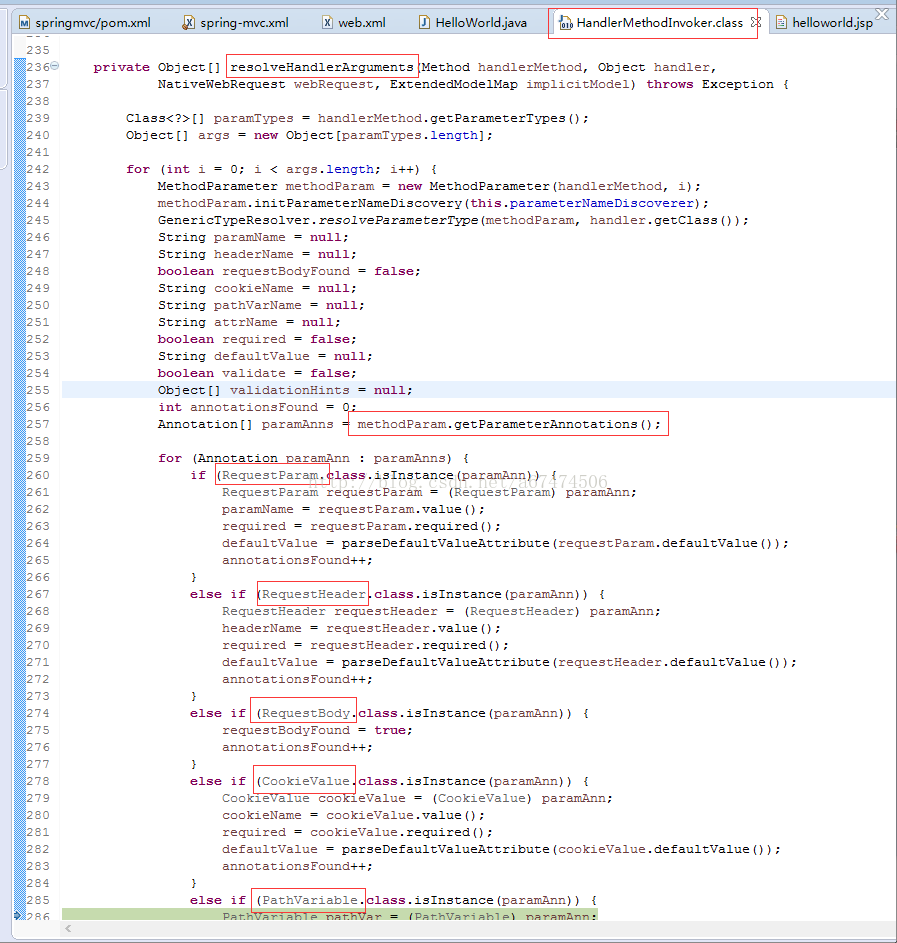1.1. @RequestMapping映射请求
SpringMVC
使用
@RequestMapping
注解为控制器指定可以处理那些
URL
请求
@requestMapping
可以定义在
类
和
方法
上
package com.ibigsea.springmvc.helloworld;
import org.springframework.stereotype.Controller;
import org.springframework.web.bind.annotation.RequestMapping;
@Controller
public class HelloWorld {
/**
* 配置@RequestMapping 拦截 localhost:8080/springmvc/hello 请求
* @return
*/
@RequestMapping("/hello")
public String helloWorld() {
System.out.println("hello world");
return "helloworld";
}
}package com.ibigsea.springmvc.helloworld;
import org.springframework.stereotype.Controller;
import org.springframework.web.bind.annotation.RequestMapping;
@Controller
@RequestMapping("/hello")
public class HelloWorld {
/**
* 配置@RequestMapping 拦截 localhost:8080/springmvc/hello/world 请求
* @return
*/
@RequestMapping("/world")
public String helloWorld(){
System.out.println("hello world");
return "helloworld";
}
}
@RequestMapping
–
类定义处
:提供初步的请求映射信息。相对于
WEB
应用的根目录
–
方法处
:提供进一步的细分映射信息。相对于类定义处的
URL
。若
类定义处未标注
@RequestMapping
,则方法处标记的
URL
相对于
WEB
应用的根目录
DispatcherServlet
截获请求后,就通过控制器上
@RequestMapping
提供的映射信息确定请求所对应的处理方法。
@RequestMapping
除了可以使用请求
URL
映射请求外,
还可以使用请求方法、请求参数及请求头映射请求
1.2. @RequestMapping限定请求方法、请求参数、请求头
/**
* 接收GET请求
* @return
*/
@RequestMapping(value="/get",method = RequestMethod.GET)
public String get(){
System.out.println("get");
return "get";
}
/**
* 接收POST请求
* @return
*/
@RequestMapping(value="/post",method = RequestMethod.POST)
public String post(){
System.out.println("post");
return "post";
}
/**
* 只接收 name 参数
* @return
*/
@RequestMapping(value="/params",params="name")
public String params(String name){
System.out.println("hello "+name);
return "helloworld";
}
/**
* 只接收请求头中 Content-Type 为 text/html;charset=UTF-8的请求
* @return
*/
@RequestMapping(value="/headers",headers="Content-Type:text/html;charset=UTF-8")
public String headers(){
System.out.println("headers");
return "helloworld";
}
1.3. @RequestMapping匹配符
–
?
:匹配文件名中的一个字符
–
*
:匹配文件名中的任意字符
–
**
:
**
匹配多层路径
实例
:
URL : /user/
*
/create
— /user/
bigsea
/create
、
/user/
sea
/create
等
URL
URL : /user/
**
/create
— /user/
big/sea
/create
、
/user/
sea/big
/create
等
URL
URL : /user/create
??
— /user/create
aa
、
/user/create
bb
1.4. @PathVariable
注解
带占位符的
URL
是
Spring3.0
新增的功能,该功能在
SpringMVC
向
REST
目标挺进发展过程中具有里程碑的意义
通过
@PathVariable
可以将
URL
中占位符参数绑定到控制器处理方法的入参中:
URL
中的
{xxx}
占位符可以通过
@PathVariable
(“xxx”)
绑定到操作方法的入参中。
/**
* localhost:8080/springmvc/hello/pathVariable/bigsea
* localhost:8080/springmvc/hello/pathVariable/sea
* 这些URL 都会 执行此方法 并且将 <b>bigsea</b>、<b>sea</b> 作为参数 传递到name字段
* @param name
* @return
*/
@RequestMapping("/pathVariable/{name}")
public String pathVariable(@PathVariable("name")String name){
System.out.println("hello "+name);
return "helloworld";
}
JSP(
这里指定全路径
):
<h1>pathVariable</h1>
<a href="${pageContext.request.contextPath}/hello/pathVariable/bigsea" > name is bigsea </a>
<br/>
<a href="${pageContext.request.contextPath}/hello/pathVariable/sea" > name is sea</a>
<br/>
运行结果
:
hello bigsea
hello sea
1.5. @RequestParam
绑定请求参数
在处理方法入参处使用
@RequestParam
可以把请求参数传递给请求方法
–
value
:参数名
–
required
:是否必须。默认为
true,
表示请求参数中必须包含对应的参数,若不存在,将抛出异常
/**
* 如果 required = true 则表示请求参数对应的 字段 必须存在.如果不存在则会抛出异常<br/>
* @param firstName 可以为null
* @param lastName 不能为null .为null报异常
* @param age age字段表示如果没有 age 参数 则默认值为 0
* @return
*/
@RequestMapping("/requestParam")
public String requestParam(@RequestParam(value="firstName",required=false)String firstName,
@RequestParam( value="lastName" ,required = true) String lastName,
@RequestParam(value="age",required = false ,defaultValue="0")int age) {
System.out.println("hello my name is " + (firstName == null ? "" : firstName)
+ lastName + "," + age +" years old this year");
return "helloworld";
}Jsp:
<a href="requestParam?firstName=big&lastName=sea" > name is bigsea , age is 0 </a>
<br/>
<a href="requestParam?lastName=sea&age=23" > name is sea , age is 23 </a>
<br/>
<a href="requestParam" > throws exception </a>
运行结果
:
hello my name is bigsea,0 years old this year
hello my name is sea,23 years old this year
1.6. @RequestHeader
获取请求头
请求头包含了若干个属性,服务器可据此获知客户端的信息,通过
@RequestHeader
即可将求头中的属性值绑定到处理方法的入参中
/**
* 获取请求头中的信息
* @RequestHeader 也有 value ,required ,defaultValue 三个参数
* @param userAgent
* @param cookie
* @return
*/
@RequestMapping("/requestHeader")
public String requestHeader(@RequestHeader("User-Agent")String userAgent,@RequestHeader("Cookie")String cookie){
System.out.println("userAgent:["+userAgent+"]");
System.out.println("cookie:["+cookie+"]");
return "helloworld";
}JSP:
<a href="requestHeader" > requestHeader </a>运行结果:
userAgent:[Mozilla/5.0 (Windows NT 6.3; WOW64) AppleWebKit/537.36 (KHTML, like Gecko) Chrome/44.0.2383.0 Safari/537.36]
cookie:[JSESSIONID=DA3B15F559349EA2C3F08BE772FCAFD8]
1.7. @CookieValue
获取
cookie
值
/**
* 使用@CookieValue 绑定cookie值<br/>
* 注解@CookieValue 也有 value ,required ,defaultValue 三个参数
* @param session
* @return
*/
public String cookieValue(@CookieValue(value = "JSESSIONID", required= false)String session){
System.out.println("JESSIONID:["+session+"]");
return "helloworld";
}JSP:
<a href="cookieValue" > cookieValue </a>运行结果
JESSIONID:[A4196EEDFD829B40CC1975F029A61328]
1.8. 源码分析







